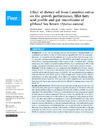Identificador persistente para citar o vincular este elemento:
https://accedacris.ulpgc.es/jspui/handle/10553/76492
| Título: | Effect of dietary oil from Camelina sativa on the growth performance, fillet fatty acid profile and gut microbiome of gilthead Sea bream (Sparus aurata) | Autores/as: | Huyben, David Rimoldi, Simona Ceccotti, Chiara Montero Vítores, Daniel Betancor, Monica Iannini, Federica Terova, Genciana |
Clasificación UNESCO: | 310502 Piscicultura | Palabras clave: | Aquaculture Fish Oil Gut Microbiota Lipid Metagenome, et al. |
Fecha de publicación: | 2020 | Proyectos: | AQUAculture infrastructures for EXCELlence in European fish research towards 2020 Genomic and nutritional innovations for genetically superior farmed fish to improve efficiency in European aquaculture |
Publicación seriada: | PeerJ | Resumen: | Background In the last two decades, research has focused on testing cheaper and sustainable alternatives to fish oil (FO), such as vegetable oils (VO), in aquafeeds. However, FO cannot be entirely replaced by VOs due to their lack of omega-3 (n-3) long-chain polyunsaturated fatty acids (LC-PUFA), particularly eicosapentaenoic (EPA; 20:5n-3) and docosahexaenoic (DHA; 22:6n-3) acids. The oilseed plant, Camelina sativa, may have a higher potential to replace FO since it can contains up to 40% of the omega-3 precursors α-linolenic acid (ALA; 18:3n-3) and linoleic acid (LA; 18:2n-6). Methods A 90-day feeding trial was conducted with 600 gilthead sea bream (Sparus aurata) of 32.92 ± 0.31 g mean initial weight fed three diets that replaced 20%, 40% and 60% of FO with CO and a control diet of FO. Fish were distributed into triplicate tanks per diet and with 50 fish each in a flow-through open marine system. Growth performance and fatty acid profiles of the fillet were analysed. The Illumina MiSeq platform for sequencing of 16S rRNA gene and Mothur pipeline were used to identify bacteria in the faeces, gut mucosa and diets in addition to metagenomic analysis by PICRUSt. Results and Conclusions The feed conversion rate and specific growth rate were not affected by diet, although final weight was significantly lower for fish fed the 60% CO diet. Reduced final weight was attributed to lower levels of EPA and DHA in the CO ingredient. The lipid profile of fillets were similar between the dietary groups in regards to total saturated, monounsaturated, PUFA (n-3 and n-6), and the ratio of n-3/n-6. Levels of EPA and DHA in the fillet reflected the progressive replacement of FO by CO in the diet and the EPA was significantly lower in fish fed the 60% CO diet, while ALA was increased. Alpha and beta-diversities of gut bacteria in both the faeces and mucosa were not affected by any dietary treatment, although a few indicator bacteria, such as Corynebacterium and Rhodospirillales, were associated with the 60% CO diet. However, lower abundance of lactic acid bacteria, specifically Lactobacillus, in the gut of fish fed the 60% CO diet may indicate a potential negative effect on gut microbiota. PICRUSt analysis revealed similar predictive functions of bacteria in the faeces and mucosa, although a higher abundance of Corynebacterium in the mucosa of fish fed 60% CO diet increased the KEGG pathway of fatty acid synthesis and may act to compensate for the lack of fatty acids in the diet. In summary, this study demonstrated that up to 40% of FO can be replaced with CO without negative effects on growth performance, fillet composition and gut microbiota of gilthead sea bream. | URI: | https://accedacris.ulpgc.es/handle/10553/76492 | ISSN: | 2167-8359 | DOI: | 10.7717/peerj.10430 | Fuente: | PeerJ [ISSN 2167-8359], n. 8:e10430 (Diciembre 2020) |
| Colección: | Artículos |
Citas SCOPUSTM
27
actualizado el 08-jun-2025
Citas de WEB OF SCIENCETM
Citations
26
actualizado el 08-jun-2025
Visitas
132
actualizado el 06-ene-2024
Descargas
86
actualizado el 06-ene-2024
Google ScholarTM
Verifica
Altmetric
Comparte
Exporta metadatos
Los elementos en ULPGC accedaCRIS están protegidos por derechos de autor con todos los derechos reservados, a menos que se indique lo contrario.
